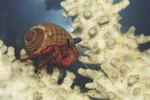
Your best defense against hermit crab diseases is proper feeding and keeping a clean environment at an appropriate temperature and humidity level. It also helps if you are familiar with your little guy's habits and behavior to help recognize when he might be in trouble so you can act ASAP.
Shell Disease
Shell disease, caused by a virus or bacterial infection, makes pockmarks or off-colored spots on the hermit crab's legs, claws and abdomen. The good news is that your little crabby can cure himself with a natural molt. You can do your part, too, by thoroughly cleaning his tank and its contents and mixing some sea salt into the fresh sand you place in his home to discourage the growth of harmful organisms that cause shell disease. Add \spirulina to his diet, too, in addition to fresh vegetables and bits of meat. Supplementing his diet with these healthy items are nutritious and will encourage a healthy molt -- but don't stop feeding his regular diet; just cut back a hair.
Mites
More than small irritants, mites can cause fatal stress to a crab. A hermit crab with mites needs bathing several times -- three or four -- over the course of a day to eliminate any of the little critters from your little critter's body and shell. Sterilize the contents of his tank by boiling it for at least 15 minutes. If you can't provide new sand, boil and drain the old, then bake it in your oven until it's dry.
Respiratory Problems
A hermit crab who doesn't have a chlorine-free supply of potable water and saltwater can develop respiratory problems. Your crab needs to keep his gills moist in order to breathe, but if you don't take care to provide him with spring water or haven't dechlorinated your tap water before giving it to him, his gills can become inflamed and blister. This cuts off his airways and can lead to suffocation.
Losing Limbs
Hermit crabs don't routinely loose a leg or a claw here and there as part of normal crab life. Although you can expect your hermit crab to molt occasionally, a red flag should go up if he loses one or more limbs. If your hermit crab begins losing his legs, he's probably stressed. Crabs who start falling apart right after you've brought them home, for instance, were probably stressed in the move. Those who start losing legs after you've had them for awhile are reacting to something newly stressing in their environment, be it temperature fluctuation, inconsistent or inadequate humidity, too much direct light, improper or insufficient water supply or molting problems. Take a close look and try to determine what is causing your little crabby to stress out and fix the problem immediately. Too much stress can have an unhappy ending.
To Quarantine or Not to Quarantine?
Hermit crabs are social little crustaceans, enjoying the company of other crabs. When you have a multiple crab community, though, one little guy coming down with a disease can affect the whole lot of them. If one of your hermits has shell disease, mites or is losing limbs, you should quarantine him in addition to thoroughly cleaning the crabitat to keep the rest of the crabs from coming down with the same thing.
Nothing Zoonotic
Thankfully, no diseases are known to transmit from hermit crabs to humans. Still, you should practice safe and healthy handling of your hermit crab, always washing your hands before and after handling him and keeping his habitat clean.
References
- "Hermit Crabs for Dummies"; Kelli A. Wilkins
- "Hermit Crab: Your Happy, Healthy Pet"; Audrey Pavia
- "Hermit Crabs"; Sue Fox
- "Secrets to Raising A Healthy Hermit Crab"; Henry Dole
- Hermit-Crabs.com: FAQ
- PetCo: Hermit Crab Care Sheet
- Tambra Nelson; Aquatic Associate, Petco; Chubbuck, Idaho
Photo Credits
-
Hemera Technologies/PhotoObjects.net/Getty Images
Writer Bio
Elle Di Jensen has been a writer and editor since 1990. She began working in the fitness industry in 1987, and her experience includes editing and publishing a workout manual. She has an extended family of pets, including special needs animals. Jensen attended Idaho and Boise State Universities. Her work has appeared in various print and online publications.




